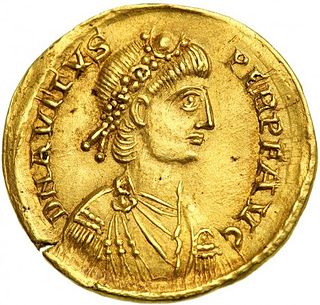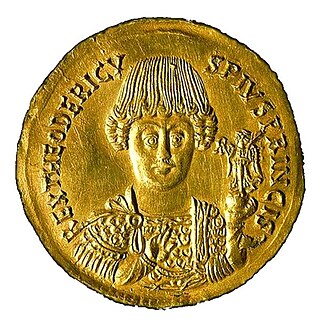Related Research Articles

The Ostrogoths were a Roman-era Germanic people. In the 5th century, they followed the Visigoths in creating one of the two great Gothic kingdoms within the Roman Empire, based upon the large Gothic populations who had settled in the Balkans in the 4th century, having crossed the Lower Danube. While the Visigoths had formed under the leadership of Alaric I, the new Ostrogothic political entity which came to rule Italy was formed in the Balkans under the influence of the Amal dynasty, the family of Theodoric the Great.

Theodoricthe Great, also called Theodoric the Amal, was king of the Ostrogoths (475–526), and ruler of the independent Ostrogothic Kingdom of Italy between 493 and 526, regent of the Visigoths (511–526), and a patrician of the Eastern Roman Empire. As ruler of the combined Gothic realms, Theodoric controlled an empire stretching from the Atlantic Ocean to the Adriatic Sea. Though Theodoric himself only used the title 'king' (rex), some scholars characterize him as a Western Roman Emperor in all but name, since he ruled large parts of the former Western Roman Empire, had received the former Western imperial regalia from Constantinople in 497, and was referred to by the title augustus by some of his subjects.

Year 511 (DXI) was a common year starting on Saturday of the Julian calendar. At the time, it was known as the Year of the Consulship of Felix and Secundinus. The denomination 511 for this year has been used since the early medieval period, when the Anno Domini calendar era became the prevalent method in Europe for naming years.

Eparchius Avitus was Roman emperor of the West from July 455 to October 456. He was a senator of Gallic extraction and a high-ranking officer both in the civil and military administration, as well as Bishop of Piacenza.

Gundobad was King of the Burgundians, succeeding his father Gundioc of Burgundy. Previous to this, he had been a patrician of the moribund Western Roman Empire in 472 – 473, three years before its collapse, succeeding his uncle Ricimer. He is perhaps best known today as the probable issuer of the Lex Burgundionum legal codes, which synthesized Roman law with ancient Germanic customs. He was the husband of Caretene.

Gesalic, Gesaleico in Spanish and Portuguese, Gesaleic in Catalan,, was a king of the Visigoths from 507 to 511, and died in 513.

The Ostrogothic Kingdom, officially the Kingdom of Italy, existed under the control of the Germanic Ostrogoths in Italy and neighbouring areas from 493 to 553.
Eutharic Cilliga was an Ostrogothic prince from Iberia who, during the early 6th century, served as Roman Consul and "son in weapons" alongside the Byzantine emperor Justin I. He was the son-in-law and presumptive heir of the Ostrogoth king Theodoric the Great but died in AD 522 at the age of 42 before he could inherit Theodoric's title. Theodoric claimed that Eutharic was a descendant of the Gothic royal house of Amali and it was intended that his marriage to Theodoric's daughter Amalasuintha would unite the Gothic kingdoms, establish Theodoric's dynasty and further strengthen the Gothic hold over Italy.
Caecina Mavortius Basilius Decius was a Roman politician under Odoacer's rule. He was consul and Praefectus urbi of Rome in 486 and Praetorian prefect of Italy from 486 to 493.
Flavius Paulinus was a Roman politician during the reign of Theodoric the Great, and was appointed consul for the year 498.
Pompeius was a politician of the Eastern Roman Empire and nephew of the Emperor Anastasius I. His family gained political prominence with the accession of Anastasius. Pompeius was consul in 501, and was elevated to the patricianate, probably by Anastasius. He held military office, serving in the Iberian War. He married a woman named Anastasia, and had at least one son. In 532, Pompeius' brother Hypatius was acclaimed emperor by the rioters during the Nika riots; after the riots were put down, both Hypatius and Pompeius were executed.
Flavius Avienus was a Roman politician during the reign of Theodoric the Great. He held the consulship with Pompeius as colleague in 501.
Ostrogothic Ravenna refers to the time period in which Ravenna, a city in Northeastern Italy, served as the capital of the Ostrogothic Kingdom, which existed between 493 and 553 CE. During that time, Ravenna saw a great renovation, in particular under Theodoric the Great (454–526). During his rule, Ravenna saw many of its finest monuments constructed or renovated, including the Basilica of Sant'Apollinare Nuovo, the Palace of Theoderic, and Mausoleum of Theodoric. Many of these monuments reflect the Arian faith of Theodoric and the Goths. Though an Arian Christian himself, Theodoric's rule was a time of religious tolerance in the city of Ravenna. His religious tolerance extended also to forging a balance between the Romans and Goths in Ravenna. Theodoric attempted to model Ravenna as a capital equivalent to that of Rome or Constantinople and as such was a defender of classical antiquity in a western world that saw much of its classical heritage disappearing.

Caecina Decius Maximus Basilius, was a Roman politician. He was the first consul appointed under Odoacer's rule (480), and afterwards was Praetorian prefect of Italy. He is best known for presiding over the papal election of Pope Felix III.
Inportunus was a Roman aristocrat who lived during the reign of Theodoric the Great. He held the consulship without colleague in 509.
Theodorus was an Italian politician during the reign of Theodoric the Great. He held the consulship with Sabinianus as his colleague in 505.
Venantius Opilio was a Roman politician during the reign of Theodoric the Great. Although he was consul as the junior colleague of emperor Justin I in 524, Opilio is best known as one of the three men whom Boethius claimed in his De consolatione philosophiae provided evidence of his treason against king Theodoric, an act which led to Boethius' imprisonment and death.
Caecina Decius Faustus Albinus was a Roman politician during the reign of Theodoric the Great. He held the consulship with Eusebius in 493. Albinus is best known for being identified with the senator whom Boethius defended from accusations of treasonous correspondence with the Eastern Roman Empire by the referandarius Cyprianus, only to have Cyprianus then accuse Boethius of the same crime.
Rufius Postumius Festus was a Roman aristocrat who lived during the Late Roman Empire. Festus was the last consul appointed by an Emperor in the West. The next consul appointed in the West was Caecina Decius Maximus Basilius, whom king Odoacer appointed in 480, eight years after Festus.
Flavius Petrus was a Roman politician during the reign of Theodoric the Great. He held the consulship without colleague in 516.
References
- "Secundinus 5", Prosopography of the Later Roman Empire , Volume 2, Cambridge University Press, 1992, ISBN 0-521-20159-4, p. 986.